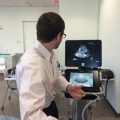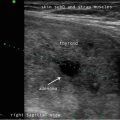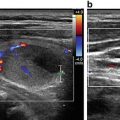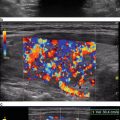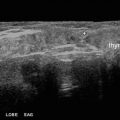Fig. 3.1
Sample form correlating the surgical pathology findings with the sonographic findings
Ultrasound equipment maintenance is an important component of AIUM practice accreditation. All ultrasound machines must be in good operating condition, with documentation of calibration and servicing at least once a year [9]. Additionally, the AIUM has very specific guidelines addressing cleaning of probes between patients and proper high-level disinfection. A background and knowledge of these guidelines is imperative to all who perform ultrasound studies [10].
Specific guidelines do exist for performance of thyroid and parathyroid ultrasound examinations, as outlined by practice parameters from the American College of Radiology, the American Institute of Ultrasound in Medicine, the Society of Pediatric Radiology (SPR), and the Society of Radiologists in Ultrasound (SRU) [11]. An inherent understanding of these practice parameters is critical to obtaining and maintaining practice accreditation.
Little has been written about authoring thyroid/parathyroid ultrasound reports [12, 13]. Minimal training other than experience is available to practicing clinicians. Many clinicians will quickly master probe positioning and even FNA biopsy. However, when moving from patient to paper, many clinicians will demonstrate significant difficulty with consistency and quality. Hence, the Validation of Competency Process (VCP) portion of the ECNU process requires proof of proficiency in reporting the ultrasound procedure. The AIUM practice guideline for documentation of an ultrasound exam explicitly sets forth the necessary components of a comprehensive ultrasound report. Both normal and abnormal findings should be documented. A clear description of the findings must be presented in an organized fashion for adequate documentation as well as communication with the referring physician or surgeon, if needed. Variations from normal should be clearly designated. Pertinent pathology should be described effectively. A succinct impression including applicable recommendations is also vital. In the event of nonroutine results, a system should be in place to communicate these results to the referring physician [12]. Reports of the ultrasound-guided procedure should include a description of the target lesion, needle gauge, the number of passes made and complications from the procedure [12].
3.5 Conclusion
In conclusion, the Endocrine Certification in Neck Ultrasound (ECNU ) program provides a certification pathway for clinicians who specialize in the management of thyroid and parathyroid disease to become recognized experts in thyroid and parathyroid sonography. Additionally, the ECNU -certified physician may receive accreditation of his/her practice by AIUM and become the laboratory director for that clinic or facility. With these credentials, physicians and their practices become recognized for excellence in thyroid and parathyroid sonography.
Acknowledgments
We greatly acknowledge the review of this chapter for content by Nickie Mizell, ECNU Certification Coordinator and by Therese Cooper BS, RDMS, AIUM Director of Accreditation.
Stay updated, free articles. Join our Telegram channel

Full access? Get Clinical Tree



